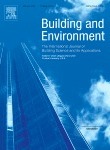Journal
Please choose volume & issue:
-
Heat removal efficiency based multi-node model for both stratum ventilation and displacement ventilation
Abstracts:The non-uniform distribution of vertical air temperature helps stratum ventilation and displacement ventilation to save energy compared with mixing ventilation. To reasonably predict the vertical distribution of the non-uniform air temperature, the multi-node (nodal) model requires an in-depth understanding of the airflow pattern and is specific for different designs of ventilation, which challenges engineers/designers in practice. To be more practical, this study proposes a heat removal efficiency (HRE) based multi-node model. The proposed model employs HRE to conveniently represent the airflow pattern, requiring little understanding of the airflow pattern. Moreover, the proposed model is general for both stratum ventilation and displacement ventilation, and flexible to include heating/cooling devices. Experimental case studies show that compared with the conventional model, the proposed model is more accurate and robust. The proposed model reduces the overall mean absolute error in the temperature predictions of the nodes of the air and inner surfaces of the enclosure by 0.1C (from 0.94C to 0.84C) for stratum ventilation, and by 0.08C (from 0.33C to 0.25C) for displacement ventilation with floor heating; and reduces the associated overall standard deviation of errors by 0.14C (from 0.55C to 0.41C) and 0.02C (from 0.19C to 0.17C) respectively. Benefiting from its convenience, generality, flexibility, accuracy and robustness, the proposed model is practical and would contribute to the practical applications of the energy-efficient stratum/displacement ventilation strategies.
-
A study of thermal comfort enhancement using three energy-efficient personalized heating strategies at two low indoor temperatures
Abstracts:There is great potential to apply personalized heating for saving energy and enhancing individual thermal comfort in buildings during cold weather. This study investigated the enhancement of thermal comfort of occupants using personalized heating systems at low indoor temperatures. Three personalized heating systems are chosen for this work, i.e., a radiant heating panel with a heated table pad (denoted as HB1), a heated chair with a heated floor mattress (denoted as HB2), and electrical heating clothing (a heated jacket and trousers, denoted as EHC). The effectiveness of three selected heating systems on overall/local body thermal comfort of female occupants under two indoor temperatures of 15 and 18 °C has been investigated. Total energy consumption of these heating systems has also been examined and compared. Thermal acceptability of EHC was better than HB1 and HB2 at both two temperatures. Overall thermal sensation vote (TSV) in EHC was significantly better than that in HB1. Mean skin temperature remained within the thermal comfort range (32–34 °C). In order to achieve thermal comfort on 70% and 80% of the inhabitants at various body parts, local body TSVs should be within −0.43 to 1.87 and −0.36 to 1.87, respectively. Further, EHC consumed <15 W power, which accounts for only 4.4% and 14.8% of the total power consumed by HB1 and HB2, respectively. Based on the evidenced thermal comfort improvement potential and low power consumption in EHC, it is thus recommended to use EHC for the thermal comfort enhancement of inhabitants under low indoor temperatures.
Hot Journals
- Risk Breakdown Matrix for Risk-Based Inspection of Transportation Infrastructure Projects
- Social Control in Outsourced Architectural and Engineering Design Consulting Projects: Behavioral Consequences and Motivational Mechanism
- 2022 Best Paper Award
- Hold-Ups and Failures in Negotiated Order: Unearthing the Nuances of Rework Causation in Construction
- Prevalence and Risk Factors for Poor Mental Health and Suicidal Ideation in the Nigerian Construction Industry
- Impact of Wind Load Characteristics on Computed Bridge Stay-Cable Forces Used for Bridge Health Monitoring
- Weak-End and Frequency Detection of Elastically Supported Bridges by Contact Residual Response of Two-Axle Test Vehicle in a Round Trip
- Development of Performance-Based Fragility Curves of Coastal Bridges Subjected to Extreme Wave-Induced Loads
- An Analytical Model to Evaluate Short- and Long-Term Performances of Post-Tensioned Concrete Box-Girder Bridges Rehabilitated by an Ultrahigh-Performance Concrete Overlay
- Experimental and Numerical Studies on Dynamic Response of Parallel Wire Cables Subjected to Close-In Explosions
- Three-Dimensional Velocity Distribution in Straight Smooth Channels Modeled by Modified Log-Law
- Experimental Investigation on Flow Past Two and Three Side-by-Side Inclined Cylinders
- An Experimental Investigation of Rotor–Box Aerodynamic Interaction 1
- Modeling Gas–Liquid Flow Between Rotating and Nonrotating Annular Disks
- Entry Length Requirements for Two- and Three-Dimensional Laminar Couette–Poiseuille Flows
Advanced Materials (3,745)
- Structured Perovskite Light Absorbers for Efficient and Stable Photovoltaics
- Strategies for High‐Performance Solid‐State Triplet–Triplet‐Annihilation‐Based Photon Upconversion
- Atomic Engineering Catalyzed MnO2 Electrolysis Kinetics for a Hybrid Aqueous Battery with High Power and Energy Density
- Crystal Adaptronics: Global Performance Indices for Dynamic Crystals as Organic Thermal Actuators (Adv. Mater. 20/2020)
- Enlightening Materials with Photoswitches
Acta Astronautica (1,768)
- Mixed-integer trajectory optimization with no-fly zone constraints for a hypersonic vehicle
- Adaptive control design for active Pogo suppression of large strap-on liquid launch vehicles
- Machine learning based approach for modeling and forecasting of GPS–TEC during diverse solar phase periods
- Effect of two-dimensional micro-cavity surface on hypersonic boundary layer
- Investigation on burning behaviors of aluminum agglomerates in solid rocket motor with detailed combustion model








 User Center
User Center My Training Class
My Training Class Feedback
Feedback






